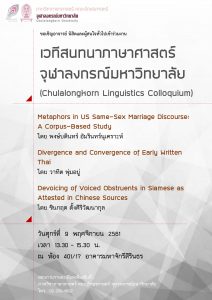ภาควิชาภาษาศาสตร์ ขอเชิญรับฟังผลงานของนิสิตภาษาศาสตร์ในงาน “เวทีสนทนาภาษาศาสตร์”
วันที่ 9 พฤศจิกายน 2561 เวลา 13.30-15.30 น.
ห้อง 401/17 อาคารมหาจักรีสิรินธร

Abstracts
Metaphors in U.S. Same–Sex Marriage Discourse: A Corpus-Based Study
Pongbodin Amarinthnukrowh
Through an integration of cognitive linguistics and corpus-assisted discourse analysis, this paper aims to investigate metaphorical expressions used in web-based news articles regarding the legalization of same-sex marriage in the United States. 172 news articles on the topic in question from January to June 2015 extracted from the NOW (News on the Web) corpus (Davies 2013) constitute the data of this study. After compiling the corpus, the USAS semantic tagger embedded in Wmatrix (Rayson 2008) was utilized to help find metaphorical expressions. Central to the U.S. same-sex marriage discourse is the war/conflict metaphor which was found to have conceptual links to other types of conventional metaphors being identified. Besides the conventional ones, novel metaphors also contribute to the construction of ideas in this discourse. In this light, a mixed, adaptive method combining ‘Conceptual Metaphor Theory’ with ‘Conceptual Blending Theory’ was employed to broaden the scope of analysis to cover both conventional and novel metaphorical expressions and gain better insights into metaphorical strategies used in this discourse.
Divergence and Convergence in Early Written Thai
Watit Pumyoo
งานวิจัยนี้เป็นการศึกษาเปรียบเทียบภาษาเขียนของไทยในยุคต้นจากคลังข้อมูลจารึกภาษาไทยช่วงก่อนพุทธศตวรรษที่ ๒๑ ซึ่งมีขนาดประมาณ ๕๐,๐๐๐ คำ พบว่าหลักฐานภาษาเขียนของไทยแรกเริ่มนั้นกำหนดอายุได้ราวปลายพุทธศตวรรษที่ ๑๙ ในบริเวณเขตเมืองเก่าสุโขทัยและพื้นที่ใกล้เคียง ต่อมาในตอนต้นพุทธศตรวรรษที่ ๒๐ ปรากฏหลักฐานภาษาเขียนในพื้นที่อื่นในเขตภาคกลางและภาคเหนือ อย่างไรก็ตามภาษาเขียนที่เก่าที่สุดที่พบนอกเขตสุโขทัยนั้นมีรูปเขียนและคำศัพท์ใกล้เคียงกับภาษาเขียนที่สุโขทัย ต่อมาเมื่อเวลาผ่านไปราวครึ่งศตวรรษในเขตภาคเหนือหรือล้านนา จึงได้ปรากฏหลักฐานตัวเขียนแบบใหม่ที่ต่างไปจากสุโขทัย แต่ในระยะต้นนั้นพบการแปรของการสะกดคำและใช้คำศัพท์ทั้งที่เหมือนและต่างจากสุโขทัย โดยภาษาเขียนที่มีความสัมพันธ์กับชนชั้นสูงมีแนวโน้มการสะกดคำและใช้คำศัพท์เหมือนกับสุโขทัยมากกว่า อย่างไรก็ตามเมื่อถึงตอนปลายพุทธศตวรรษที่ ๒๐ พบว่าภาษาเขียนในเขตล้านนาใช้รูปแปรของการเขียนแบบสุโขทัยลดลงและมีแนวโน้มการใช้รูปเขียนแบบท้องถิ่นมากขึ้น ซึ่งเป็นช่วงเวลาเดียวกับที่สุโขทัยได้ตกเป็นเมืองขึ้นของอยุธยา และภาษาเขียนของล้านนาเริ่มแยกออกจากภาษาเขียนของสุโขทัยอย่างชัดเจนเมื่อเข้าสู่ปลายพุทธศตวรรษที่ ๒๐ ส่วนภาษาเขียนของสุโขทัยมีแนวโน้มของการสะกดคำและใช้คำศัพท์ใกล้เคียงกับอยุธยา
Devoicing of Voiced Obstruents in Siamese as attested in Chinese sources
Shinnakrit Tangsiriwattanakul
Devoicing of Voiced Obstruents (DVO) and the later tonal split and mergers form a transformative series of sound changes that affected all Tai languages. Although previous studies show that they occurred before the 17th century (Harris, 1992; Pittayawat 2016), their precise dating is still unclear. While Brown (1965) and Chamberlain (1991) hold that DVO occurred prior to 13th Century, Shintani (1974) and Gedney (1989) place it around 14th-17th Century. To arrive at the chronology of the sound change, I examine transcriptions of Siamese words in Míng Shí Lù(Chinese: 明實錄), an almost 3 centuries Dynastic annals of the Ming dynasty. All the data are taken from the following address and its related pages: http://www.epress.nus.edu.sg/msl/introduction, an online open access of the English translation of the MSL by Geoff Wade, with glossary provided along. An examination of MSL reveals that most cases of voiced stops in Siamese personal names were transcribed with Chinese characters with initial unaspirated stops prior to 1440, e.g. Nài Sīwù Luózhě(Chinese: 柰斯勿羅者) for Nāy Smut Rājā(Siamese: นายสมุทรราชา). After 1470, this pattern was replaced by one that uses characters with aspirated onsets, e.g. Kūn Tiē Xiètí(Chinese: ) for Khun Dēp Sētthī (ขุนเทพเศรษฐี) , suggesting that DVO took place between 1440 – 1470.

